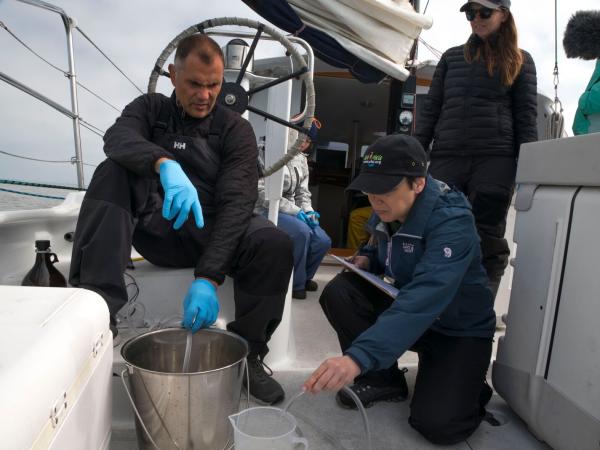Data Services
Our Team in the Data Services
The San Francisco Estuary Institute comprises over sixty scientists, technologists, and designers who offer a wide range of expertise. Each team member, in her or his own way, helps to define environmental problems, advance public debate about them through sound science, and support consensus-based solutions that improve environmental planning, management, and policy development.
Projects Related to the Data Services
 The Pulse of the Bay
The Pulse of the Bay
https://www.sfei.org/documents/2019-pulse-bay-pollutant-pathwaysDownload the Pulse of the Bay! This report from the Regional Monitoring Program for Water Quality in San Francisco Bay features articles on the four major pathways by which pollutants enter the Bay: municipal wastewater, industrial wastewater, stormwater, and dredging and dredged sediment disposal. Each article provides a basic introduction to the pathway and discusses the regulatory framework, recent findings, and future challenges. The report also includes some of the latest highlights from monitoring of important parameters such as nutrients, emerging contaminants, mercury, PCBs, and selenium.
 RMP Update
RMP Update
The Regional Monitoring Program for Water Quality in San Francisco Bay is an innovative collaboration of the San Francisco Bay Regional Water Quality Control Board, the regulated discharger community, and the San Francisco Estuary Institute. It provides water quality regulators with the information they need to manage the Bay effectively. The RMP produces two types of summary reports: The Pulse of the Bay and the RMP Update. The Pulse focuses on Bay water quality and summarizes information from all sources.
 Perfluoroalkyl and Polyfluoroalkyl Substances (PFAS)
Perfluoroalkyl and Polyfluoroalkyl Substances (PFAS)
A recent analysis of PFAS in the surface waters of SF Bay was conducted to understand the occurrence, fate, and potential risks to ecological and human health. Eleven of 40 PFAS were detected at part per trillions (ppt) concentrations in ambient water collected in 2021 from 22 sites in the Bay. Seven PFAS (PFPeA, PFHxA, PFHpA, PFOA, PFBS, PFHxS, and PFOS), were found in at least 50% of samples. Concentrations of PFAS in the Bay were generally consistent with similar studies globally for surface water. Sustained, multi-matrix monitoring of this important class of contaminants of emerging concern is a high priority for the RMP.
 Microplastic Pollution in San Francisco Bay
Microplastic Pollution in San Francisco Bay
Plastic pollution is gaining global recognition as a threat to the resilience and productivity of ocean ecosystems. However, we are only just beginning to understand the scope and impacts of microplastic particles (less than 5 mm) on coastal and ocean resources, and the San Francisco Bay Area is no exception. A preliminary study of nine water sites in San Francisco Bay, published in 2016, showed greater levels of microplastics than the Great Lakes or Chesapeake Bay.
 California Environmental Data Exchange Network (CEDEN)
California Environmental Data Exchange Network (CEDEN)
The California Environmental Data Exchange Network (CEDEN) is a central location to find and share information about California’s surface waters, including streams, lakes, rivers, and the coastal ocean.
 Geospatial Compliance Monitoring System
Geospatial Compliance Monitoring System
The Geospatial Compliance Monitoring System (GCMS) is an online database that records all biological opinions and the information associated with them to ensure that requisite actions are tracked, monitored, and enforced.
To this end, the GCMS houses a customized set of information, tailored to the needs of the US Fish and Wildlife Service (USFWS) regarding the projects occurring in Southern California (associated with its Carlsbad office). The system then issues notices based on overdue conservation measures on a daily basis.
 Regional Data Center
Regional Data Center
SFEI is one of the state's Regional Data Centers that exchanges water quality data to the California Environmental Data Exchange Network (CEDEN). SFEI provides data management and visualization services to the San Francisco Bay-Delta and northern montane regions.
 Contaminant Data Download and Display (CD3)
Contaminant Data Download and Display (CD3)
Contaminant Data Display and Download Tool or CD3 is an innovative visualization tool for accessing water quality data for the San Francisco Bay-Delta and northern montane regions. It is the primary tool for accessing and downloading the San Francisco Bay Regional Monitoring Program’s (RMP) long-term dataset and other project data stored in SFEI's Regional Data Center (RDC).
 Wetlands Regional Monitoring Project
Wetlands Regional Monitoring Project
This Prop 50 - funded project was a three-year effort to monitor and track changes in Bay Area wetland condition. This wetland monitoring toolkit meets basic information needs for managing wetlands: to develop a scientific framework with standard methods for monitoring wetlands and for interpreting the results, and to regularly report the findings to the public. These monitoring tools are intended to help provide a public measure of the environmental costs or benefits of most wetland management actions.
 Visualizing and Sharing Intensive Data Assessments
Visualizing and Sharing Intensive Data Assessments
With California's drought rapidly changing the outlook for natural resources, decision-makers must be equipped with information and tools that facilitate clear and rapid decisions. The proposed grant would fund the standardization, visualization, and sharing of Level 3 data.
- 1 of 2
- next ›
Publications related to the Data Services
The Institute has collectively produced more than 1300 reports, articles, and other publications over the course of its 24-year existence. The following list represents those publications associated with this individual program and its focus areas.
Nothing found
Year of Publication: 2023
. Data Management Procedures: For Lake County Water Resources Department (LCWRD) and Habematolel Pomo Of Upper Lake (HPUL) Tribe Water Quality Monitoring Data. 2023 p. 18. Report No.: 1140.  (4.22 MB)
(4.22 MB)
Year of Publication: 2017
Year of Publication: 2016
. Project Tracker Access Levels - Graphic. 2016.  (284.25 KB)
(284.25 KB)
Year of Publication: 2015
. CD3 Contaminant Data Display & Download: Innovative Visualization Tool for Accessing Water Quality Data. 2015 RMP Annual Meeting; 2015.  (1.94 MB)
(1.94 MB)
. Estuary-Wide Data Repository Poster (2015). 2015.  (4.38 MB)
(4.38 MB)
. Factsheet: Innovative Visualization Tool or Accessing Water Quality Data. 2015.  (3.62 MB)
(3.62 MB)
. Project Tracker Factsheet. 2015.  (3.88 MB)
(3.88 MB)
. Stream Health of the Coyote Creek and Guadalupe River Watersheds using WRAMP. Richmond, CA; 2015.  (5.69 MB)
(5.69 MB)



